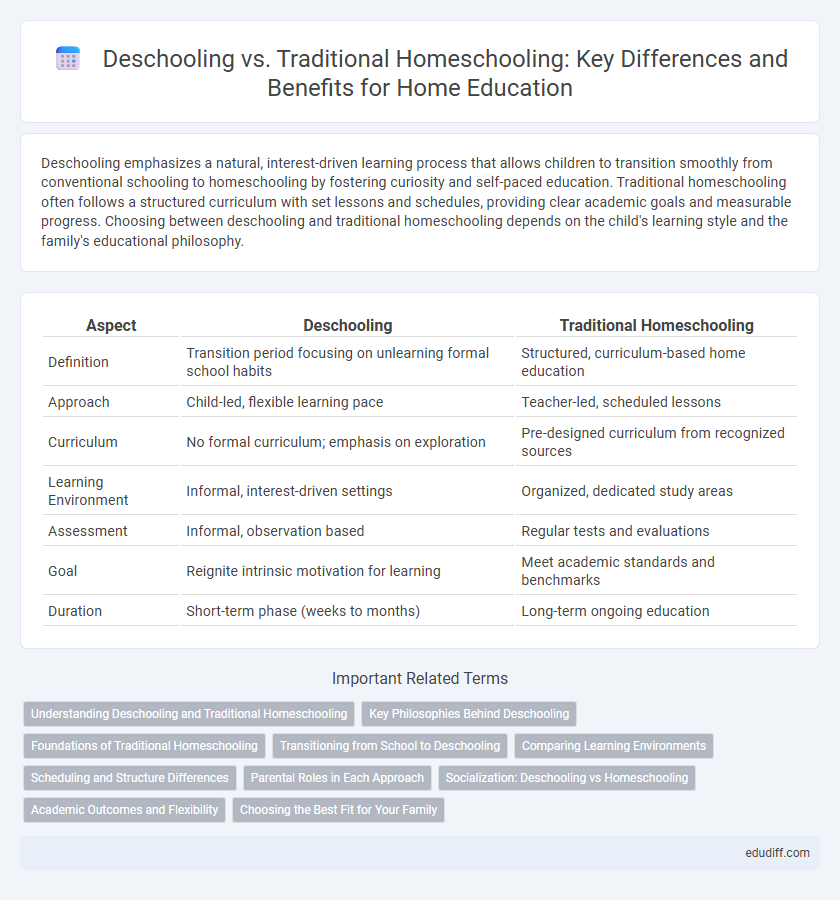Deschooling emphasizes a natural, interest-driven learning process that allows children to transition smoothly from conventional schooling to homeschooling by fostering curiosity and self-paced education. Traditional homeschooling often follows a structured curriculum with set lessons and schedules, providing clear academic goals and measurable progress. Choosing between deschooling and traditional homeschooling depends on the child's learning style and the family's educational philosophy.
Table of Comparison
| Aspect | Deschooling | Traditional Homeschooling |
|---|---|---|
| Definition | Transition period focusing on unlearning formal school habits | Structured, curriculum-based home education |
| Approach | Child-led, flexible learning pace | Teacher-led, scheduled lessons |
| Curriculum | No formal curriculum; emphasis on exploration | Pre-designed curriculum from recognized sources |
| Learning Environment | Informal, interest-driven settings | Organized, dedicated study areas |
| Assessment | Informal, observation based | Regular tests and evaluations |
| Goal | Reignite intrinsic motivation for learning | Meet academic standards and benchmarks |
| Duration | Short-term phase (weeks to months) | Long-term ongoing education |
Understanding Deschooling and Traditional Homeschooling
Deschooling involves a transitional period that helps children and parents shift from conventional classroom mindsets to a more flexible, self-directed learning approach embraced by homeschooling. Traditional homeschooling follows structured curricula, schedules, and assessments similar to formal school settings, ensuring systematic academic progress. Understanding these differences helps families choose educational methods aligned with their values and their children's learning styles.
Key Philosophies Behind Deschooling
Deschooling emphasizes unstructured learning, allowing children to explore their interests at their own pace without the constraints of traditional curriculum or standardized assessments. Rooted in the belief that formal schooling can stifle creativity and natural curiosity, deschooling promotes learning through real-life experiences, self-directed projects, and intrinsic motivation. This approach contrasts with traditional homeschooling, which often mirrors conventional education with set schedules, lesson plans, and formal evaluations.
Foundations of Traditional Homeschooling
Traditional homeschooling is grounded in structured curricula emphasizing core subjects like mathematics, reading, and science, often mirroring public school standards to ensure academic consistency. It relies on scheduled lessons, standardized assessments, and a teacher-led approach to provide a clear framework for student progress. Parents or tutors act as primary educators, focusing on mastery of content through repetition and formal instruction methods.
Transitioning from School to Deschooling
Transitioning from traditional schooling to deschooling involves a critical period where learners unlearn the structured routines and standardized expectations ingrained by conventional education systems. This phase prioritizes restoring natural curiosity and intrinsic motivation through flexible, learner-driven experiences rather than fixed curricula and assessments. Emphasizing self-paced discovery and diverse learning environments facilitates smoother adaptation and fosters a resilient, autonomous educational mindset.
Comparing Learning Environments
Deschooling promotes a flexible, child-led learning environment that encourages exploration and natural curiosity, contrasting with traditional homeschooling's structured curriculum and scheduled lessons. In deschooling, the absence of formal assessments fosters intrinsic motivation, while traditional homeschooling often relies on standardized testing to measure progress. This fundamental difference shapes how children engage with educational content and develop critical thinking skills.
Scheduling and Structure Differences
Deschooling emphasizes flexible scheduling and learner-led exploration, allowing children to follow their natural interests without rigid time constraints. Traditional homeschooling often uses structured lessons and fixed timetables to mirror conventional school environments, with clear daily schedules and planned subjects. This contrast in scheduling and structure highlights Deschooling's adaptability versus the routine-driven approach of traditional homeschooling.
Parental Roles in Each Approach
Parental roles in deschooling emphasize facilitating a child-led learning environment where parents act as guides and supporters, encouraging curiosity without imposing structured lessons. In traditional homeschooling, parents typically adopt the role of instructor, responsible for planning, teaching, and assessing educational progress through a formal curriculum. These contrasting approaches highlight the balance between parental involvement as either facilitators of independent exploration or as authoritative educators.
Socialization: Deschooling vs Homeschooling
Deschooling emphasizes unstructured socialization through community engagement and peer interaction, fostering organic social skills development outside conventional academic settings. Traditional homeschooling often incorporates structured social activities such as co-ops, sports teams, and classes to simulate school-like social environments. Research indicates that deschooled children may develop more adaptable social abilities by engaging with diverse age groups, whereas traditionally homeschooled children benefit from consistent peer group exposure.
Academic Outcomes and Flexibility
Deschooling emphasizes a child-led learning approach, often resulting in flexible schedules that cater to individual interests, which can enhance creativity and intrinsic motivation compared to traditional homeschooling's structured curriculum. Studies reveal that while traditional homeschooling often achieves measurable academic outcomes through standardized testing, deschooling promotes deeper conceptual understanding and critical thinking by allowing students to explore knowledge at their own pace. The flexibility inherent in deschooling supports personalized education plans, enabling learners to balance academic goals with emotional and social development more effectively than rigid homeschooling frameworks.
Choosing the Best Fit for Your Family
Selecting between deschooling and traditional homeschooling depends on your family's educational goals and learning preferences. Deschooling emphasizes a relaxed, child-led approach that fosters natural curiosity and self-paced learning, appealing to families seeking flexibility and reduced structure. Traditional homeschooling offers a more structured curriculum and routine, ideal for parents who prefer clear academic benchmarks and consistent lesson plans to guide their child's progress.
Deschooling vs Traditional Homeschooling Infographic

 edudiff.com
edudiff.com